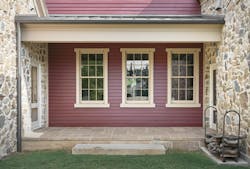Q+A: Maker of The '100 Year Window' Explains Its Durability
It’s not everyday that a builder designs a window to be used by other builders. But that is the case for the 100 Year Window, a product that promises the classic beauty of historically authentic windows built with the durability and dependability of modern building science.
The 100 Year Window by Hull Millworks is the brainchild of historic restoration expert Brent Hull, who apart from producing the product is also the founder and owner of Hullworks, a custom build firm operating out of Fort Worth, Texas. Recently, we sat down with Hull to learn a little bit more about this product, its unique design, and why its creator feels confident enough say that it’s “built to last for 100 years.”
Residential Products Online (RPO): 100 Year Windows use "tropical hardwood sapele, white oak, and long-leaf yellow pine." What is it about those wood varieties that make them so good for windows?
Brent Hull (BH): The challenge for many builders today is that too often doors and windows rot out too quickly. They don’t understand that it is because most mills use cheap woods that won’t last. Forest Products Labs has done research on the decay resistance of heart woods. Most pines are rated in the worst category: “non-resistant” to rot. Many builders then push for fiberglass/plastic windows and doors because they don’t know what else to do. All three woods listed are superior long lasting woods to build with.
Sapele, a mahogany cousin, is a dense, long lasting tropical hardwood that lasts very long.
White oak has proven to be a long-lasting exterior hardwood. It has great historic precedent. Builders need to make sure they do not specify red oak, as it does not last long on the exterior of homes.
Long Leaf Yellow pine is an old growth old over from the past that has proven to last a long time on historic buildings.
RPO: Your windows are built without finger joints. What is the benefit?
BH: Finger-jointed wood is a post-1950’s “solution” for the end of virgin forests in America. Finger joining wood was a “solution” for manufacturers to cut knots and defects from boards and then glue them back together. The problem is that you can’t glue the end grains of wood to each other because the glue can’t hold onto the end grain fiber of wood. The fingers are an attempt to overcome this end-grain problem, but the joints always open up and telegraph through the paint. Finger-jointed wood is a bad solution if you are looking for something to last 100+ years.
The window's V-groove bronze weatherstripping, according to Hull, "allows for expansion and contraction while helping with air infiltration and making the windows easily operable."
RPO: Your windows also use "single pane, putty-glazed glass." What is the benefit?
BH: Single-pane glass is a product that can last 1000 years. It is very long lasting. Insulated glass is a 10-20 year product that requires replacement when the seal fails. Putty glazing is a sacrificial product that holds glass into the wood but is also the first to fail if water gets in for an extended period of time. With wood glazing or wood stops, when water gets in, it has nowhere to go and ends up rotting all wood parts. The window parts rot out more completely when there is not a sacrificial product like putty glazing.
RPO: Where does historic meet modern in the window's design and assembly?
BH: The glass is the weak link in all windows. Wood is an excellent insulator. Building a window out of wood is very energy-efficient and economical. Further, when wood windows are weather-stripped and built well they perform as good as any window on the market. The single-pane glass in hot climates can be improved with low-e coatings and advanced window films. These can cut heat gain and UV transmission without great expense. In cold climates historic storms, interior storms and the Pilkington Spacia glass all offer superior insulation than standard double pane glass.
RPO: Why do you feel so confident saying the 100-year window will last 100 years?
BH: We have been doing window restoration on historic buildings for 30 years. We know why those windows last so long: the wood quality is superior. If we can provide a superior/long lasting wood and build using historic methods, there is no reason these windows won’t last 100 years or longer.
Find additional product information on the 100 Year Window here.

